Powerflows in hybrid vehicles
17. November, 2010, Autor článku: Matej Juraj, Elektrotechnika
Ročník 3, číslo 11  Pridať príspevok
Pridať príspevok
 The paper deals about analysis of power flows in the hybrid electric vehicle. This paper presents analysis of an optimal energy management and control system for a parallel hybrid electric truck. This paper deals about control strategy in efficiency mode for hybrid electric vehicle powertrains. Control strategies are algorithms that choose the power split between the engine and motor of a hybrid vehicle in order to minimize the fuel consumption or emissions.
The paper deals about analysis of power flows in the hybrid electric vehicle. This paper presents analysis of an optimal energy management and control system for a parallel hybrid electric truck. This paper deals about control strategy in efficiency mode for hybrid electric vehicle powertrains. Control strategies are algorithms that choose the power split between the engine and motor of a hybrid vehicle in order to minimize the fuel consumption or emissions.
Control strategy in efficiency mode utilizes to minimize specific fuel consumption of engine and maximize an efficiency of internal combustion engine and hybrid electric vehicle powertrain too. Dynamic Programming techniques are utilized to determine the optimal control for a hybrid electric vehicle powertrain in order to minimize fuel consumption and maximize efficiency of hybrid electric powertrain. A dynamic programming method to determine the optimal power split between both sources of energy. In this energy control strategy are very important power characteristics of engine, motor and vehicles power for optimal control of engine load.
In this paper are described an optimal characteristics of control strategy in efficiency mode and the dynamic characteristic of vehicle in ideal and efficiency mode of control strategy of hybrid electric vehicle powertrain. It is described an ideal distribution of energy flows or optimal energy flows of hybrid electric vehicle powertrain in which are not inclusive parameters like optimal engine temperature or state of charge etc.
Introduction
This paper deals about powerflows in hybrid electric truck with help of dynamic programming optimation control. In parallel configuration of hybrid drivetrain are drive units of vehicle connected in parallel. Vehicle can be propelling with motor, engine or both. Dynamic programming is a mathematical operation where we find optimal variables to minimize a cost function for example function of specific consumption. This papers deals about power distribution between drive units and generator in the hybrid electric truck. There is design of powerflow control for hybrid electric truck as well as results of measurents hybrid electric powertrain of truck.
1. Dynamic programming method
Contrary to the rule-based algorithm, the dynamic optimization approach usually relies on a model to compute the best control strategy. The model can be either analytical or numerical; in other words, it can work with numerical black boxes. For a given driving cycle, the optimal operating strategy to deliver the best fuel economy can be obtained by solving a dynamic optimization problem. A numerical dynamic programming approach will be applied to solve this finite horizon optimization problem. [1] In the discrete-time format, a model of the hybrid electric vehicle can be expressed as:
| (1) |
where u(k) is the vector of control variables such as fuel injection rate to the engine (kg/cycle), desired output torque from the motor (Nm), and gear shift command to the transmission, and x(k) is the vector of state variables of the system. The sampling time has been selected to be one second. The goal of the optimization scheme is to find the optimal control input, u(k), which minimizes the total fuel consumption over a driving cycle. This defines the cost function to be minimized as follows:
| (2) |
where N is the time length of the driving cycle, and L is the instantaneous fuel consumption rate. During the optimization procedure, it is necessary to impose certain inequality constraints on the states and control to ensure they remain within their corresponding bounds:
| (3) |
| (4) |
| (5) |
where omega-e is the engine angular speed and T m is the motor torque. In addition, equality constraints are imposed so that the vehicle always meets the speed and load demands of the specific driving cycle. Since the above problem formulation does not impose a charge sustaining policy, the optimization algorithm tends to deplete the battery in order to attain minimal fuel consumption. Hence, a final state constraint on SOC should be imposed to account for maintaining the energy of the battery and to achieve a fair comparison of fuel economy. A soft terminal constraint on SOC (quadratic penalty function) is added to the cost function as follows:
| (6) |
where G(x(N))=a(SOC(N)-SOCI) z represents the penalty associated with the error in the terminal SOC; SOC I is the desired SOC at the final time; and c~ is a weighting factor. [1]
The detailed HE-VESIM model is not suitable for the purpose of dynamic optimization because its complexity leads to low computation efficiency. Dynamic Programming is well-known to require computations that grow exponentially with the number of states. A simplified vehicle model is thus developed for optimization purposes. The engine, torque converter, differential, and electric motor are reduced to static models with look-up tables for I/O mapping and efficiencies. Since the gear shifting duration is about one second, the automatic transmission was approximated to be a gearbox with gear number as the state.
For this reason, the control to the transmission is constrained to take on the values of – l , 0, and 1 for downshift, no shift and upshift, respectively. The other state left is the battery SOC that is dynamically updated by the battery current. The simplified model was found to approximate well the complex model except under rapid transients. A powerful algorithm to solve the above optimization problem is to use Dynamic Programming (DP). Based on Bellman’s principle of optimality, the DP algorithm is presented as follows [1]:
Step N-1
| (7) |
Step k, 0 ≤ k < N-1
| (8) |
The recursive equation is solved backwards from step N-1 to 0 in order to find the optimal control policy. Each of the minimizations is performed subject to the constraints and the driving cycle. The standard method to solve a Dynamic Programming problem numerically is to use quantization and interpolation [1]. The state and control values are first quantized into finite grids. At each step of the DP algorithm, the function Jk(x(k)) is evaluated only at the grid points. If the next state, x(k + 1), does not fall exactly on to a quantized value, then function interpolation is used to determine the values of J*k+l(x(k + l)) as well as G(x(N)).
Despite the use of a simplified model, the long horizon of the UDDSHDV driving cycle makes the direct application of the above algorithm computationally infeasible for today’s technology. Several approaches have been adopted to accelerate the computational speed [1]. From the velocity profile of the driving cycle, the vehicle model can be replaced by a finite set of operating points parameterized by wheel torque and speed. Pre-computed look-up tables are constructed for recording next states and instantaneous cost as a function of quantized states, control inputs, and operating points. Once these tables are built, they can be used to update in a very efficient manner [1].
The dynamic programming procedure produces an optimal, time-varying, state-feedback control policy that is stored in a table for each of the quantized states and time stages, i.e., u* (x(k),k); this function is then used as a state feedback controller in the simulations. It should be noted that dynamic programming creates a family of optimal paths for all possible initial conditions. In our case, once the initial SOC is given, the optimal policy will find an optimal way to bring the final SOC back to the terminal value (SOCf ) while achieving the minimal fuel consumption.
2. Power-flows
The power required to drive a vehicle depends on the following factors:
- Rolling resistance of the tire with road
- Aerodynamic drag
- Inertial resistance in acceleration
- Grade resistance
- Transmission losses
- Ancillary loads; i e, air conditioner, lights, stereo etc.
Since grade resistance is not included in all standard drive cycles, the effect of grade resistance in HEV design is neglected in this paper. The effect of air velocity is also eliminated from the simulations. Thus, total power demanded by the vehicle from its power plant is expressed as:
| (9) |
where, P is vehicle power demand in watts, v is velocity of the car in m/s, ff is coefficient of rolling resistance, M is vehicle weight in kg, g is acceleration of gravity in m/s2, r is air density in kg/m3, Cd is coefficient of air drag, A is frontal area of the vehicle in m2, d is mass factor which includes the effect of rotational inertia, ηt is transmission efficiency and Paux is the power required to drive the ancillary (hotel) loads in watts.
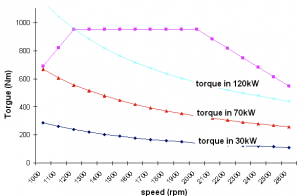
Figure: 1 Engine power limit in the hybrid electric truck
On the figure 1 we can see distribution of operating engine area to torques with constant power. It is engine area distribution to power limits. Operating area of engine is distribute to 4 areas. First operating area of engine represents power to 30kW. Power from 30 to 70 kW is limited by second operating area of engine. Power to 120 kW is represent third operating area and power more than 120 kW present last one, fourth operating engine area.
In the first area, vehicle is driving by motor as we can see on the figure 2. It is no convent if in this power space vehicle was drive by engine, because in this required power engine is working with low efficiency and with high brake specific fuel consumption. In the second area, vehicle is driving by engine which distributes its power to driving wheels and to generator at the same time. Power of the engine must be use to drive the vehicle and charging batteries too. Thereby engine is working with higher efficiency.
In the third operating engine area, engine is driving the vehicle without assist motor/generator. Load of engine is in this region optimal for its efficiency and specific fuel consumption. Vehicle is propelling by engine like in convention vehicles. If the required power to drive is higher than 120 kW, engine power is only 120 kW and required power to drive the vehicle is delivering from the motor. So, motor assist to engine. Engine has constant power by reason of minimal specific fuel consumption and required power is delivering by motor.
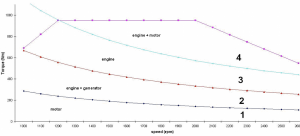
Figure 2: Drive unit distribution depend on engine speed characteristic power limits
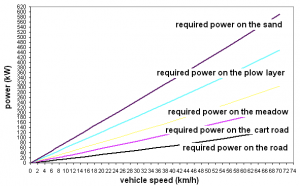
Figure 3: Road power to hybrid electric truck
Power flows is designed by required power of the vehicle and not by vehicle driving speed. It means that different roads make different vehicle speed to change the powerflow of hybrid electric truck. Figure 3 present this situation.
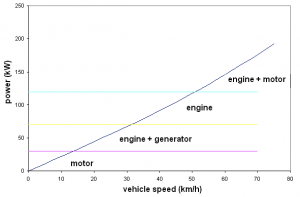
Figure 4: Power unit distribution depend on road power limit
Figure 4 shows powerflows distribution of drive units in depends on required power with hybrid electric truck. Figure 4 present distribution of required power to drive the vehicle on given road to 4 areas so look like distribution in the speed characteristic of engine. Low load required to drive the vehicle is propel by motor. Uplift power from road putting in operation the engine which transler its power to driving wheels and to generator too. Engine load is given by required power to drive the vehicle and power required to charge batteries. In follow up uplifting the required power to drive the vehicle engine drives the vehicle. In this situation engine deliver the power only to driving wheels without charging batteries. In the maximum road load the vehicle is driving by engine and motor together. Motor helps to engine to driving the vehicle in the maximum road load.
This situation better shows figure 5. We can see powerflows of driving units hybrid electric truck during vehicle drive. Always is valid that summary of engine power and motor power is equal to required power to drive the vehicle. The red line represent required power to drive the vehicle, blue line represent engine power, purple line represent motor power. In the figure 5 is present that engine power is used only in close volume during all volume of drive. That makes it possible to use engine operating points close to minimal specific fuel consumption.
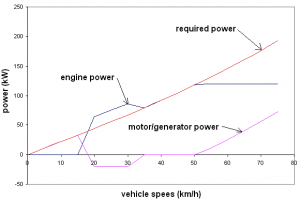
Figure 5: Hybrid electric truck powerflows
3. Measurement results
Up listed theory of hybrid electric truck powerflows is in next figures verified by practical measurements of hydrid electric truck drivetrain. Figure 6 presents engine and motor/generator operating points distribution by up list theory. In low required power to drive the vehicle motor is used to drive. Engine with motor assist working only in close volume of specific fuel consumption.
When required power is high engine power does not increase its power but keeps the constant power and power required to drive is compensated by motor power. Blue points represents engine operating points and yellow points represents motor/generator operating points. In the given engine operating area, engine works alone without motor/generator assist so look like in the up list of this paper.
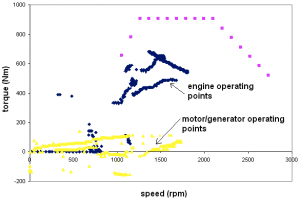
Figure 6: Power distribution in engine speed characteristic
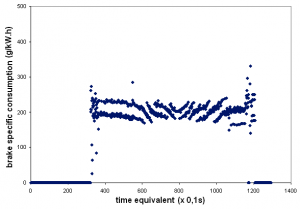
Figure 7: Brake specific consumption flow
Figure 7 represents run of brake specific fuel consumption during drive the vehicle. We can see that engine use relatively only constant brake specific fuel consumption during all power volume of vehicle. It is due to distribution of powerflows between engine, motor/generator basically on power. This is reason why the engine works only in region with low brake specific consumption for all volume of required vehicle power.
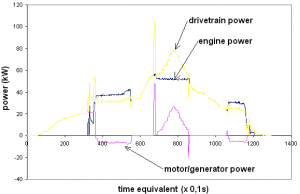
Figure 8: Hybrid Electric Truck Powerflow
Figure 8 presents run of powerflow of hybrid electric truck drive units and generator. Low required power to drive is repression by the motor, reason is low engine efficiency in these working areas. Come through from figure 8 that increase power what is need to drive, vehicle is drive by engine which distribute its powerflow to driving wheels and to generator too.
This is the reason why we can decrease brake specific fuel consumption of engine which working only in areas with high efficiency. The next increase required power to drive, all of the drive forces are repression by engine power which is not under load from generator now because engine working with highest efficiency. The next increase required power engine power does not increase but keeps the constant value. Rest of required power is equal by motor power. Power summary of engine and motor/generator must be equal to required power to drive the vehicle.
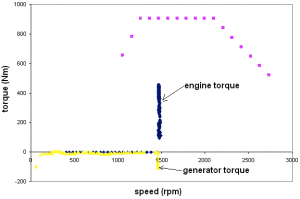
Figure 9: Powerflow during charging
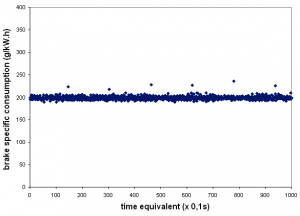
Figure 10: Brake specific consumption flow during charging
We can see engine and motor operating points during the charging mode on figure 9. We can set up the engine power to optimal value in which working in lowest brake specific fuel consumption. Figure 10 represents run of brake specific fuel consumption during charging the batteries. We can see that engine works in constant brake specific fuel consumption, which can be at the same time the minimal brake specific fuel consumption of engine. But it is very strongly depended on batteries actual state of charge.
Conclusion
Optimization of hybrid electric drivetrains has major signification to achievement minimize fuel consumption, production of emissions or maximize drivetrain effieciency of vehicle. Experimental measurement results prove increase of drivetrain efficiency, because brake specific fuel consumption is kept on relatively constant value for all driving range. Working area of engine is optimized by motor/generator so that ongine operation points are only in areas with lowest specific fuel consumption.
Hybrid electric drivetrain is not only cooperation between engine and motor/generator, it is especially optimization of engine working area or all hybrid powertrain by motor/generator. This way can provide decrease of fuel consumption and (or) emission producing of the vehicle.
Reference
- Lin, Ch., Kang, J., Grizzle, J, Peng, H.:: Energy managment strategy for a paralel hybrid electric truck, Proceedings of the Amarican Control Conference, Arlington, VA June 25-27, 2001
- Lin, Ch., Peng, H.,Grizzle, J.: power management strategie for a paralel hybrid electric truck, Proceedings of the 2002 Mediterranean Control Conference, Lisbon, Portugal, July 2002.
- Wu, B., Lin, Ch., Filipi, Z., Peng, H., Assanis, D.: Optimization of Power Management Strategies for a Hydraulic Hybrid Medium Truck, Proceedings of the 2002 Advanced Vehicle Control Conference, Hiroshima, Japan, September 2002
- Rahman, Butler, Ehsani: A Study of Design Issues on Electrically Peaking Hybrid Electric Vehicle for Diverse Urban Driving Patterns, Texas A&M University
1999 Society of Automotive Engineers, Inc.

